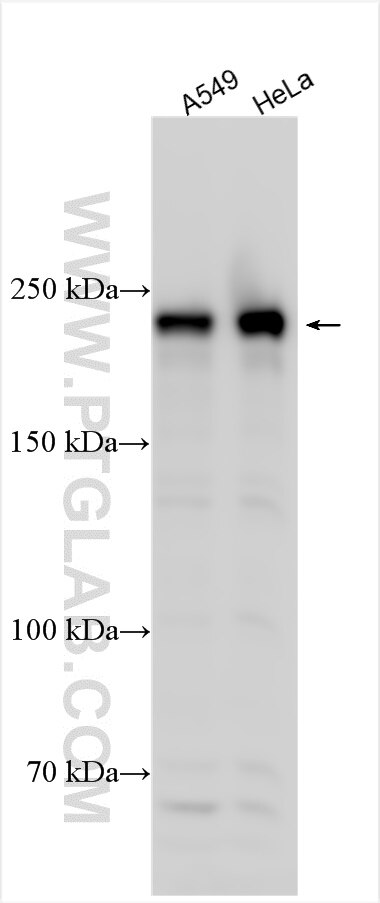Tested Applications
| Positive WB detected in | A549 cells, HeLa cells |
Recommended dilution
| Application | Dilution |
|---|---|
| Western Blot (WB) | WB : 1:500-1:1000 |
| It is recommended that this reagent should be titrated in each testing system to obtain optimal results. | |
| Sample-dependent, Check data in validation data gallery. | |
Product Information
31702-1-AP targets CDK5RAP2 in WB, ELISA applications and shows reactivity with human samples.
| Tested Reactivity | human |
| Host / Isotype | Rabbit / IgG |
| Class | Polyclonal |
| Type | Antibody |
| Immunogen | CDK5RAP2 fusion protein Ag36245 Predict reactive species |
| Full Name | CDK5 regulatory subunit associated protein 2 |
| Calculated Molecular Weight | 1893 aa, 215 kDa |
| Observed Molecular Weight | 210-215 kDa |
| GenBank Accession Number | BC146782 |
| Gene Symbol | CDK5RAP2 |
| Gene ID (NCBI) | 55755 |
| RRID | AB_3670087 |
| Conjugate | Unconjugated |
| Form | Liquid |
| Purification Method | Antigen affinity Purification |
| UNIPROT ID | Q96SN8 |
| Storage Buffer | PBS with 0.02% sodium azide and 50% glycerol, pH 7.3. |
| Storage Conditions | Store at -20°C. Stable for one year after shipment. Aliquoting is unnecessary for -20oC storage. 20ul sizes contain 0.1% BSA. |
Background Information
Cyclin-dependent kinase 5 regulatory subunit associated protein 2 (CDK5RAP2) is a pericentriolar matrix (PCM) protein that regulates centriole engagement and centrosome cohesion during the cell cycle. CDK5RAP2 is associated with several cancers, including breast cancer, oral squamous cell carcinoma and haematological malignancies.
Protocols
| Product Specific Protocols | |
|---|---|
| WB protocol for CDK5RAP2 antibody 31702-1-AP | Download protocol |
| Standard Protocols | |
|---|---|
| Click here to view our Standard Protocols |



